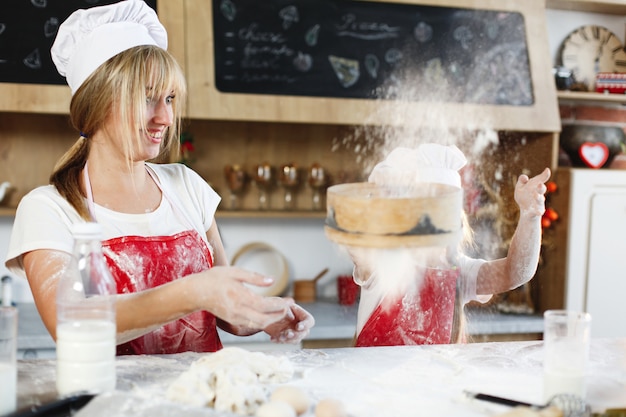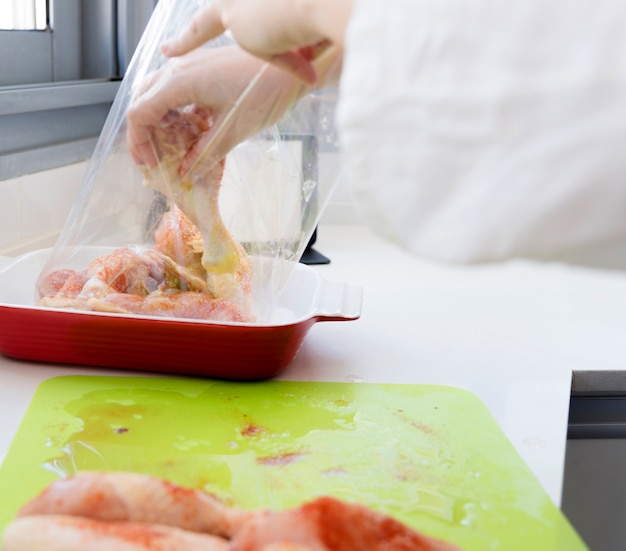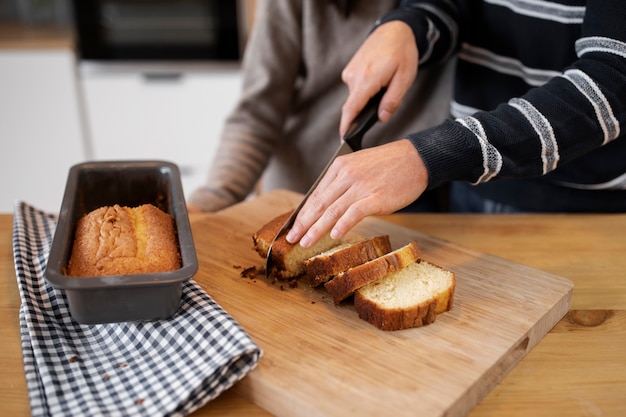Ah, the humble ham. A classic for a reason, isn't it? It's the ultimate crowd-pleaser, a showstopping centerpiece that makes any gathering feel special. There's something undeniably comforting about a juicy, flavourful slice of ham, whether it's a casual Sunday dinner or a grand holiday feast. Over the years, I've baked countless hams, and I've learned a thing or two about getting them perfectly cooked and bursting with flavour.
Now, don't get me wrong, oven-baked ham is surprisingly straightforward. You don't need a fancy culinary degree or a million ingredients to create a delicious dish. But mastering the timing and temperature is crucial. And that's where my guide comes in. We'll dive into everything from choosing the right ham to prepping it, ensuring it's cooked to perfection, and finally, the all-important glazing that elevates your ham to a whole new level.
So, grab your apron, gather your ingredients, and let's get started on this delicious journey!
(Part 1) Ham 101

Choosing the Right Ham: A Matter of Taste
Let's face it, not all hams are created equal. The first big decision you'll need to make is between a bone-in or boneless ham. bone-in hams are a bit more traditional, offering a richer flavour and a beautiful presentation. They're usually more budget-friendly too. Boneless hams, on the other hand, are easier to carve, offering neat and even slices. Personally, I love the added flavour of the bone, so I usually go for a bone-in ham.
Next, you need to choose the type of ham. Here's a breakdown of the most common options:
- spiral-sliced ham: This is your go-to for convenience. It's already sliced, making it a breeze to carve. These hams are usually pre-cooked, meaning you only need to reheat them in the oven. They're fantastic for busy weeknights or gatherings where you don't want to spend a lot of time in the kitchen.
- whole ham: This is the "from scratch" option, typically raw and requiring cooking from start to finish. It might take a little longer, but it rewards you with a more intense flavour. In my experience, whole hams also have a better texture after cooking. If you're looking for that authentic, old-fashioned ham experience, a whole ham is the way to go.
Lastly, consider the size of your ham. Think about the number of guests you'll be serving and your appetite. Hams come in a variety of sizes, so you can find one that fits your needs. For my own gatherings, I typically go for a bone-in, whole ham, and I usually err on the side of larger sizes. I'm a firm believer in having plenty to go around. But smaller hams can be perfect for smaller gatherings or busy weeknight dinners. Ultimately, choose the ham that suits your taste and the occasion.
Prepping the Ham: A Little Effort Goes a Long Way
Once you've chosen your perfect ham, it's time for a bit of pre-cooking prep. This step ensures a delicious and flavourful ham.
If your ham is pre-cooked, simply remove it from its packaging and place it in a roasting pan. Now, let's talk about scoring. Scoring is the act of making shallow cuts into the fat of the ham. This helps the fat render, creating a beautiful golden crust and releasing a fantastic flavour. Use a sharp knife and cut about 1/4 inch deep, making sure not to go through the meat.
And then there's the glaze! This is where the magic happens. It's the finishing touch that elevates your ham to a whole new level of deliciousness. There are endless possibilities when it comes to ham glazes, but some classics include brown sugar, honey, mustard, and even pineapple juice. Experiment and find what you love. I'm partial to a simple brown sugar and honey glaze, as it strikes the perfect balance of sweet and savoury.
You can apply the glaze directly to the ham before you put it in the oven, or you can save it for the last 30 minutes of cooking. It's really up to you! I've found that applying the glaze later helps create a more caramelized crust.
For an extra flavour boost, I like to add a few things to the roasting pan. A cup of water or chicken broth will create steam, keeping the ham moist. You can also add a few sprigs of rosemary, a bay leaf, or even a few cloves of garlic for a subtle flavour enhancement.
Cooking Time and Temperature: Getting it Right
Now, let's get down to the nitty-gritty of cooking. Determining the right cooking time and temperature is essential for a perfectly cooked ham.
First things first, you need to determine if your ham is pre-cooked or raw. pre-cooked hams are already cooked and only need to be reheated. raw hams, on the other hand, need to be cooked to an internal temperature of 145°F (63°C) to ensure they are safe to eat.
Here's a general guide for cooking times and temperatures:
| Ham Type | Weight | Cooking Time | Temperature |
|---|---|---|---|
| Pre-cooked Ham | 10-12 pounds | 15-20 minutes per pound | 325°F (160°C) |
| Raw Ham | 10-12 pounds | 20-25 minutes per pound | 325°F (160°C) |
These are just general guidelines, though. It's always a good idea to use a meat thermometer to ensure your ham is cooked to the proper temperature. You can find them at most grocery stores for a few pounds. They are so worth the investment! They'll save you a lot of stress, especially when cooking a whole ham.
For pre-cooked hams, the cooking time is mainly for reheating and allowing the glaze to caramelize. Always follow the instructions on the package for the best results with your specific ham.
With raw hams, you'll need to cook them until they reach that safe internal temperature of 145°F (63°C). Always check the temperature in the thickest part of the ham, as it takes the longest to cook.
Remember, when in doubt, it's always better to err on the side of caution and cook your ham a little longer. Trust me, there's nothing worse than an undercooked ham! I learned this lesson the hard way at a family gathering. It was a total disaster! Since then, I always make sure my ham is cooked to the proper temperature. It's a good rule to live by.
(Part 2) The Art of Glazing

Time to Glaze: Turning Ordinary into Extraordinary
Okay, so your ham is in the oven, slowly but surely reaching that perfect internal temperature. Now, it's time to consider the glaze. It's the final touch that takes your ham from good to phenomenal. It adds a beautiful shine, a burst of delicious flavour, and a touch of sweetness that will have everyone begging for seconds.
As I mentioned earlier, there are countless glaze options. Don't be afraid to experiment and find your own favourite. Here are a few of my personal go-to glazes:
- Classic brown sugar glaze: Simple, yet oh-so-delicious. Combine brown sugar, honey, and a touch of mustard in a bowl, and whisk until smooth. Brush it onto your ham in the last 30 minutes of cooking.
- honey mustard glaze: This adds a delightful tangy, sweet, and savoury flavour to your ham. Combine honey, mustard, and a splash of lemon juice in a bowl, and whisk until smooth. Brush it onto your ham in the last 30 minutes of cooking.
- pineapple glaze: This glaze infuses your ham with a sweet and fruity flavour. Combine pineapple juice, brown sugar, and a pinch of ginger in a saucepan, and simmer until thickened. Brush it onto your ham in the last 30 minutes of cooking.
- Spicy maple glaze: This glaze brings a kick of spice to your ham. Combine maple syrup, brown sugar, chili powder, and a touch of cayenne pepper in a saucepan, and simmer until thickened. Brush it onto your ham in the last 30 minutes of cooking.
No matter which glaze you choose, brush it onto your ham in the last 30 minutes of cooking. This allows the glaze to caramelize, creating a beautiful, glossy finish. While the ham is in the oven, keep an eye on it and brush it with the glaze every 10 minutes or so. This ensures the glaze is evenly distributed and your ham is perfectly glazed.
Feel free to get creative and add your own twist to the glaze! Experiment with different fruits, spices, herbs, and even liquors. The possibilities are truly endless!
Carving Perfection: A Masterful Presentation
Your ham is cooked to perfection, the glaze is looking beautiful and glossy. Now comes the grand finale - carving!
Carving a ham might seem daunting at first, but it's really not that difficult. Here are a few tips for carving a ham like a pro:
- Let the ham rest: Before you begin carving, let the ham rest for 15-20 minutes. This allows the juices to redistribute, resulting in a more juicy and flavorful ham.
- Use a sharp knife: A sharp knife makes carving a breeze and prevents the ham from tearing.
- Start with the bone-in: If you’re carving a bone-in ham, start by carving around the bone. Carefully slice the ham away from the bone, and then slice the ham into thin pieces.
- Carve against the grain: Carving against the grain will result in more tender slices.
Don't be afraid to ask for help if you need it. If you're unsure of how to carve a ham, ask a friend, family member, or butcher for assistance. And remember, practice makes perfect. The more you carve hams, the more confident you'll become.
(Part 3) Beyond the Basics

ham storage Tips: Keeping Leftovers Delicious
You've cooked the perfect ham, carved it beautifully, and enjoyed a delicious meal. Now you're left with leftover ham. Don't worry, it can be just as delicious as the original! You just need to store it properly to keep it fresh and flavorful.
Here are some tips for storing leftover ham:
- Refrigerate it properly: Wrap the leftover ham tightly in plastic wrap or aluminum foil, or place it in an airtight container. You can also freeze leftover ham for up to 2 months.
- Don't let it sit out: Never leave leftover ham at room temperature for more than two hours. Bacteria can grow rapidly at room temperature, which can make you sick.
Remember to always check the expiration date on your ham. If the ham has passed its expiration date, it's best to discard it.
Leftover Ham Inspiration: A World of Possibilities
Leftover ham is a blank canvas for culinary creativity. It's a versatile ingredient that can be used in a variety of dishes. Here are a few ideas to inspire your next culinary adventure:
- ham and cheese sandwiches: A classic for a reason! Simply slice leftover ham and cheese between two pieces of bread for a quick and easy lunch or snack.
- Ham and potato soup: This comforting soup is a fantastic way to use up leftover ham. Combine diced ham, potatoes, onions, carrots, and chicken broth in a pot, and simmer until the potatoes are tender.
- Ham quiche: This savory quiche is a delicious and elegant way to use up leftover ham. Combine ham, cheese, and eggs in a pie crust, and bake until set.
- Ham and bean salad: This salad is perfect for a light and refreshing meal. Combine diced ham, beans, corn, and your favourite salad dressing.
- Ham fried rice: Add some leftover ham to your next fried rice dish for a flavour boost.
These are just a few ideas to get you started. Use your imagination and experiment with different recipes. You might be surprised at what delicious creations you come up with!
(Part 4) Common Mistakes to Avoid
Over the years of cooking countless hams, I've learned from my mistakes. I've also seen others make mistakes when cooking ham. Here are some common mistakes to avoid:
- Overcooking the ham: Overcooking a ham can make it dry and tough. Always check the internal temperature of your ham with a meat thermometer to ensure it is cooked to the proper temperature.
- Not letting the ham rest: Letting the ham rest after cooking allows the juices to redistribute, resulting in a more juicy and flavorful ham.
- Using a dull knife: A dull knife will make carving difficult and can cause the ham to tear. Use a sharp knife for the best results.
- Not removing the ham from the pan before carving: This can create a mess and make carving more difficult. Always remove the ham from the roasting pan before you begin carving.
Avoiding these common mistakes will help you ensure that your ham is cooked to perfection and that your carving experience is a success.
(Part 5) FAQs
What is the best way to reheat leftover ham?
The best way to reheat leftover ham is in the oven. Preheat your oven to 325°F (160°C) and place the ham in a roasting pan. Reheat for 15-20 minutes, or until the ham is heated through. You can also reheat ham in the microwave, but it may become dry and tough.
Can I freeze leftover ham?
Yes, you can freeze leftover ham for up to 2 months. Wrap the ham tightly in plastic wrap or aluminum foil, or place it in an airtight container. To thaw frozen ham, place it in the refrigerator overnight.
What does it mean if my ham is "spiral sliced"?
Spiral-sliced ham is a type of ham that has been pre-sliced and rolled up. This makes it very easy to carve and serve. Spiral-sliced hams are usually pre-cooked, so they only need to be reheated.
What is the difference between a bone-in ham and a boneless ham?
Bone-in hams have a bone, while boneless hams do not. Bone-in hams are generally more flavorful, but boneless hams are easier to carve and serve.
Can I make a ham glaze from scratch?
Absolutely! There are countless recipes for ham glazes online. You can use your favourite ingredients to create a custom glaze that will elevate your ham to a whole new level.
And there you have it! Your complete guide to oven-baked ham. Now go forth and create delicious memories!
Everyone is watching

Perfect Rice Every Time: The Ultimate Guide to Cooking Rice
Cooking TipsAs a self-proclaimed foodie, I've always been a bit obsessed with rice. It's the foundation of countless cuisi...

Prime Rib Roast Cooking Time Chart: Per Pound Guide
Cooking TipsPrime rib roast. Just the name conjures images of lavish dinners, crackling fires, and hearty laughter. It’s ...

The Ultimate Guide to Cooking Asparagus: Tips, Techniques, and Recipes
Cooking TipsAsparagus. The mere mention of this spring delicacy conjures up images of vibrant green spears, crisp and burs...

Ultimate Guide to Cooking the Perfect Thanksgiving Turkey
Cooking TipsThanksgiving. Just the word conjures up images of overflowing tables laden with delicious food, the scent of r...

How Long to Bake Potatoes in the Oven (Perfect Every Time)
Cooking TipsBaked potatoes are a staple in my kitchen. They're incredibly versatile, delicious, and surprisingly easy to m...
